[English] 日本語
 Yorodumi
Yorodumi- PDB-1onv: NMR Structure of a Complex Containing the TFIIF Subunit RAP74 and... -
+ Open data
Open data
- Basic information
Basic information
| Entry | Database: PDB / ID: 1onv | ||||||
|---|---|---|---|---|---|---|---|
| Title | NMR Structure of a Complex Containing the TFIIF Subunit RAP74 and the RNAP II CTD Phosphatase FCP1 | ||||||
 Components Components |
| ||||||
 Keywords Keywords | TRANSCRIPTION / Transcription Factor / Human General Transcription Factor TFIIF / RAP74 / RNA Polymerase II CTD Phosphatase / TFIIF-associating CTD Phosphatase / FCP1 | ||||||
| Function / homology |  Function and homology information Function and homology informationRNA polymerase II CTD heptapeptide repeat phosphatase activity / negative regulation of cell growth involved in cardiac muscle cell development / phosphatase activator activity / TFIIF-class transcription factor complex binding / transcription factor TFIIF complex / exit from mitosis / Tat protein binding / host-mediated activation of viral transcription / RNA polymerase II general transcription initiation factor binding / Abortive elongation of HIV-1 transcript in the absence of Tat ...RNA polymerase II CTD heptapeptide repeat phosphatase activity / negative regulation of cell growth involved in cardiac muscle cell development / phosphatase activator activity / TFIIF-class transcription factor complex binding / transcription factor TFIIF complex / exit from mitosis / Tat protein binding / host-mediated activation of viral transcription / RNA polymerase II general transcription initiation factor binding / Abortive elongation of HIV-1 transcript in the absence of Tat / FGFR2 alternative splicing / Viral Messenger RNA Synthesis / Signaling by FGFR2 IIIa TM / RNA polymerase II general transcription initiation factor activity / transcription factor TFIID complex / protein-serine/threonine phosphatase / RNA Pol II CTD phosphorylation and interaction with CE during HIV infection / RNA Pol II CTD phosphorylation and interaction with CE / spindle midzone / HIV Transcription Initiation / RNA Polymerase II HIV Promoter Escape / Transcription of the HIV genome / RNA Polymerase II Promoter Escape / RNA Polymerase II Transcription Pre-Initiation And Promoter Opening / RNA Polymerase II Transcription Initiation / RNA Polymerase II Transcription Initiation And Promoter Clearance / Formation of the Early Elongation Complex / Formation of the HIV-1 Early Elongation Complex / mRNA Capping / mRNA Splicing - Minor Pathway / Processing of Capped Intron-Containing Pre-mRNA / phosphoprotein phosphatase activity / Pausing and recovery of Tat-mediated HIV elongation / Tat-mediated HIV elongation arrest and recovery / RNA polymerase II transcribes snRNA genes / HIV elongation arrest and recovery / Pausing and recovery of HIV elongation / Tat-mediated elongation of the HIV-1 transcript / Formation of HIV-1 elongation complex containing HIV-1 Tat / Formation of HIV elongation complex in the absence of HIV Tat / protein dephosphorylation / negative regulation of protein binding / RNA Polymerase II Transcription Elongation / Formation of RNA Pol II elongation complex / RNA Polymerase II Pre-transcription Events / mRNA Splicing - Major Pathway / TP53 Regulates Transcription of DNA Repair Genes / transcription initiation at RNA polymerase II promoter / transcription elongation by RNA polymerase II / promoter-specific chromatin binding / positive regulation of transcription elongation by RNA polymerase II / response to virus / spindle / spindle pole / cell junction / midbody / protein phosphatase binding / Estrogen-dependent gene expression / transcription by RNA polymerase II / protein domain specific binding / cell division / intracellular membrane-bounded organelle / centrosome / positive regulation of transcription by RNA polymerase II / protein-containing complex / DNA binding / RNA binding / nucleoplasm / nucleus / cytoplasm Similarity search - Function | ||||||
| Biological species |  Homo sapiens (human) Homo sapiens (human) | ||||||
| Method | SOLUTION NMR / torsion angle dynamics | ||||||
 Authors Authors | Nguyen, B.D. / Abbott, K.L. / Potempa, K. / Kobor, M.S. / Archambault, J. / Greenblatt, J. / Legault, P. / Omichinski, J.G. | ||||||
 Citation Citation |  Journal: Proc.Natl.Acad.Sci.USA / Year: 2003 Journal: Proc.Natl.Acad.Sci.USA / Year: 2003Title: NMR Structure of a Complex Containing the TFIIF Subunit RAP74 and the RNA polymerase II carboxyl-terminal domain phosphatase FCP1 Authors: Nguyen, B.D. / Abbott, K.L. / Potempa, K. / Kobor, M.S. / Archambault, J. / Greenblatt, J. / Legault, P. / Omichinski, J.G. | ||||||
| History |
|
- Structure visualization
Structure visualization
| Structure viewer | Molecule:  Molmil Molmil Jmol/JSmol Jmol/JSmol |
|---|
- Downloads & links
Downloads & links
- Download
Download
| PDBx/mmCIF format |  1onv.cif.gz 1onv.cif.gz | 565.3 KB | Display |  PDBx/mmCIF format PDBx/mmCIF format |
|---|---|---|---|---|
| PDB format |  pdb1onv.ent.gz pdb1onv.ent.gz | 467 KB | Display |  PDB format PDB format |
| PDBx/mmJSON format |  1onv.json.gz 1onv.json.gz | Tree view |  PDBx/mmJSON format PDBx/mmJSON format | |
| Others |  Other downloads Other downloads |
-Validation report
| Summary document |  1onv_validation.pdf.gz 1onv_validation.pdf.gz | 362.1 KB | Display |  wwPDB validaton report wwPDB validaton report |
|---|---|---|---|---|
| Full document |  1onv_full_validation.pdf.gz 1onv_full_validation.pdf.gz | 638.8 KB | Display | |
| Data in XML |  1onv_validation.xml.gz 1onv_validation.xml.gz | 32.6 KB | Display | |
| Data in CIF |  1onv_validation.cif.gz 1onv_validation.cif.gz | 51.5 KB | Display | |
| Arichive directory |  https://data.pdbj.org/pub/pdb/validation_reports/on/1onv https://data.pdbj.org/pub/pdb/validation_reports/on/1onv ftp://data.pdbj.org/pub/pdb/validation_reports/on/1onv ftp://data.pdbj.org/pub/pdb/validation_reports/on/1onv | HTTPS FTP |
-Related structure data
| Similar structure data |
|---|
- Links
Links
- Assembly
Assembly
| Deposited unit | 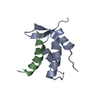
| |||||||||
|---|---|---|---|---|---|---|---|---|---|---|
| 1 |
| |||||||||
| NMR ensembles |
|
- Components
Components
| #1: Protein | Mass: 9344.814 Da / Num. of mol.: 1 Fragment: C-Terminal Domain of RAP74, sequence database residues 436-517 Source method: isolated from a genetically manipulated source Source: (gene. exp.)  Homo sapiens (human) / Plasmid: GST-2T / Species (production host): Escherichia coli / Production host: Homo sapiens (human) / Plasmid: GST-2T / Species (production host): Escherichia coli / Production host:  |
|---|---|
| #2: Protein | Mass: 9022.545 Da / Num. of mol.: 1 Fragment: C-Terminal Domain of FCP1, sequence database residues 760-842 Source method: isolated from a genetically manipulated source Source: (gene. exp.)  Homo sapiens (human) / Plasmid: GST-3X / Species (production host): Escherichia coli / Production host: Homo sapiens (human) / Plasmid: GST-3X / Species (production host): Escherichia coli / Production host:  |
-Experimental details
-Experiment
| Experiment | Method: SOLUTION NMR | ||||||||||||||||||||||||||||||||||||||||
|---|---|---|---|---|---|---|---|---|---|---|---|---|---|---|---|---|---|---|---|---|---|---|---|---|---|---|---|---|---|---|---|---|---|---|---|---|---|---|---|---|---|
| NMR experiment |
| ||||||||||||||||||||||||||||||||||||||||
| NMR details | Text: The structure was determined using triple-resonance NMR spectroscopy |
- Sample preparation
Sample preparation
| Details |
| ||||||||||||||||||||||||
|---|---|---|---|---|---|---|---|---|---|---|---|---|---|---|---|---|---|---|---|---|---|---|---|---|---|
| Sample conditions | Ionic strength: 20mM sodium phosphate buffer / pH: 6.5 / Pressure: ambient / Temperature: 300 K | ||||||||||||||||||||||||
| Crystal grow | *PLUS Method: other / Details: NMR |
-NMR measurement
| Radiation | Protocol: SINGLE WAVELENGTH / Monochromatic (M) / Laue (L): M | ||||||||||||||||||||
|---|---|---|---|---|---|---|---|---|---|---|---|---|---|---|---|---|---|---|---|---|---|
| Radiation wavelength | Relative weight: 1 | ||||||||||||||||||||
| NMR spectrometer |
|
- Processing
Processing
| NMR software |
| ||||||||||||||||||||||||
|---|---|---|---|---|---|---|---|---|---|---|---|---|---|---|---|---|---|---|---|---|---|---|---|---|---|
| Refinement | Method: torsion angle dynamics / Software ordinal: 1 Details: The structures were determined based on a total of 1267 restraints, 1131 NOE-derived distance restraints (including 58 intermolecular NOE-derived distance restraints) and 136 dihedral angle restraints | ||||||||||||||||||||||||
| NMR representative | Selection criteria: closest to the average,minimized average structure | ||||||||||||||||||||||||
| NMR ensemble | Conformer selection criteria: structures with acceptable covalent geometry,structures with the least restraint violations,structures with the lowest energy Conformers calculated total number: 70 / Conformers submitted total number: 20 |
 Movie
Movie Controller
Controller


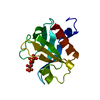
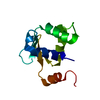

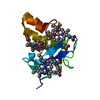

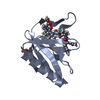
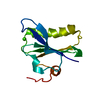
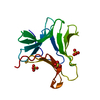

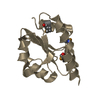
 PDBj
PDBj












 NMRPipe
NMRPipe